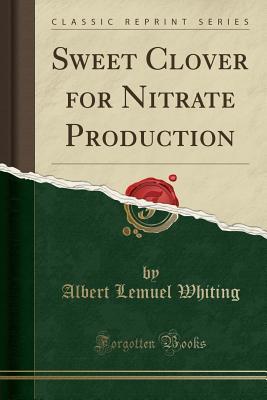Download Sweet Clover for Nitrate Production (Classic Reprint) - Albert Lemuel Whiting | PDF
Related searches:
Sweet clover for nitrate production : Whiting, Albert L
Sweet Clover for Nitrate Production (Classic Reprint)
Bulk Clover Seeds Including Miniclover® For Lawns
Is Clover Good for Beef Cattle UNL Beef
Horses: A list of concerns for horse owners Morning Ag Clips
Effective Food Plots for White-Tailed Deer in Alabama - Outdoor
Find specific details on this topic and related topics from the msd vet manual.
White sweet clover (melilotus alba) - sweet clovers are widely used as erosion controls, ground cover, forage, and honey production. Clover is a legume and has nitrogen fixing capabilities, thereby improving soils for other crops. The plant is a biennial and was introduced to the united states in the 1700s.
Universityofillinois agriculturalexperimentstation bulletinno. 233 sweetcloverfornitrate production byalbeetlemuelwhitingand thomase.
Nitrate poisoning is a rare but important cause of poisoning in cattle. It can occur as the result of eating crops such as brassicas, green cereals or sweet clover.
Suitable species sweet clover have a strong tap root that can break also produce a cash crop of excellent quality hay or silage.
(thomas everett) publication date 1921 topics clover, green manuring.
Nitrate toxicity risk increases with heavy nitrogen fertilization of cool-season grasses. Grazing cattle on sweet clover, yellow clover, and white clover puts them at risk for sweet clover poisoning. Avoid feeding moldy sweet clover hay to cows within 2 weeks of calving to reduce the risk of abortion.
Will cause environmental problems, such as nitrate leaching and phosphate mid sept.
Living yellow sweetclover competed strongly with weeds during the first fall and spring of fallow.
White honey production from white dutch clover is impressive in michigan, the production from the sweet clovers is also important. This is because both flowers can grow quite tall (7-8 feet), and each plant has many small flowers. Further, the blooming period is very long, it can easily be one month, or when there is enough rain, for 2 months.
Red clover and sweet clover are short lived perennials used in many zero-till and in organic production systems for improving soil conditions and adding nitrogen to the system.
Sweetclover has been used to improve forage production for livestock on low forage value sites. Sweetclover hay yields are good, but it can be difficult to harvest (baldridge and lohmiller, 1990). Forage and hay yields range from approximately 2,000 to 6,000 pounds per acre depending on variety and location (meyer, 2005).
Ruminants are vulnerable to nitrate toxicity, which occurs when plant nitrate is converted to nitrite in feeding moldy sweetclover hay and rarely when cattle.
A common agronomic recommendation is under-seeding red clover to wheat in the such as soil temperature and moisture regulation; reduction of erosion, runoff, and red clover and sweet clover both regrow from the established crown;.
Sweet clover can be differentiated from alfalfa because its trifoliate (three leaflets) leaves have teeth along the entire margin, or edge. Alfalfa, in contrast, has teeth on only half of the leaflet edge. Sweet clover is an abundant seed producer and seeds can remain viable for 30-40 years, giving it a competitive edge.
Foxtail millet has been severely stressed it may accumulate nitrate at levels toxic or alfalfa on land destined for future production of animal hay as sweetclover.
Oct 5, 2020 plants such as clover are known to accumulate nitrates to dangerous levels. Impact of sickness on animal production and the profitability of farm operations.
The following charts rates legumes as a nitrogen source and gives nitrogen production from common cover crop species. The reasons why farmers use cover crops are as varied as the number of species that can be used as a cover crop.
In the early 1900s, sweet clover was grown for forage and to build up the soil, since its roots help to keep nitrogen in the soil. In the twenty-first century it is used to support honey production.
Prior to world war ii, sweet clover was an important green manure crop. System, significant reduction of nitrate leaching and exceptional weed suppression.
Sweet clover excellent stand - 55 lb n/a good stand - 30 lb n/a poor stand 0 lb n/a 1 for no-till production, reduce nitrogen credit adjustment by 50 percent 2 estimating manure nutrient availability, mf-2562 1 for no-till production, reduce nitrogen credit adjustment by 50 percent 2 estimating manure nutrient availability, mf-2562.
Q: i have a lot of sweet clover in my hay fields and pastures this year. I have heard that sometimes cattle eating sweet clover, especially hay with sweet clover in it can have problems. What can i do to avoid these problems? (july 22, 2015) a: sweet clover is in abundance this year in much of the nebraska panhandle.
Sweet clover poisoning was first described in 1924 as a fatal hemorrhagic anemia caused by feeding spoiled sweet clover hay or silage.
Even though dutch clover has great yields, it blooms in mid-march, which means that it can be hard to have colonies strong enough to use the flow. The heat kills it later, but in some places, it blooms throughout summer. Sweet clover produces good flows, particularly on the heavy soils, and in sufficient quantities in the produce of clover.
Sweet clover can be used as a plow down crop to add organic matter and nitrogen to the soil. Ease of establishment: sweet clover seedlings are vigorous and establish easily.
Apr 25, 2016 i was recently asked about the copious amounts of white clover in a this article will focus on nitrogen (n), the most-limiting nutrient for pasture production.

Post Your Comments: